 News
News
Discussion Session 2: Sustainable export - The key to business success
Coordinator: Ms. Nguyen Thao Hien - Deputy Director of the European - American Market Department
The participation in signing a series of Free Trade Agreements (FTAs) over the past time has created momentum for Vietnam's import and export activities to grow more effectively. However, besides the advantages that FTAs bring, we are also facing more stringent non-tariff regulations from FTA markets, especially new generation FTAs such as CPTPP or EVFTA. Notably, the tightening of environmental/climate issues, green transition, and sustainable development. FTA partners are also increasingly stepping up the implementation and monitoring of the chapters related to this issue.
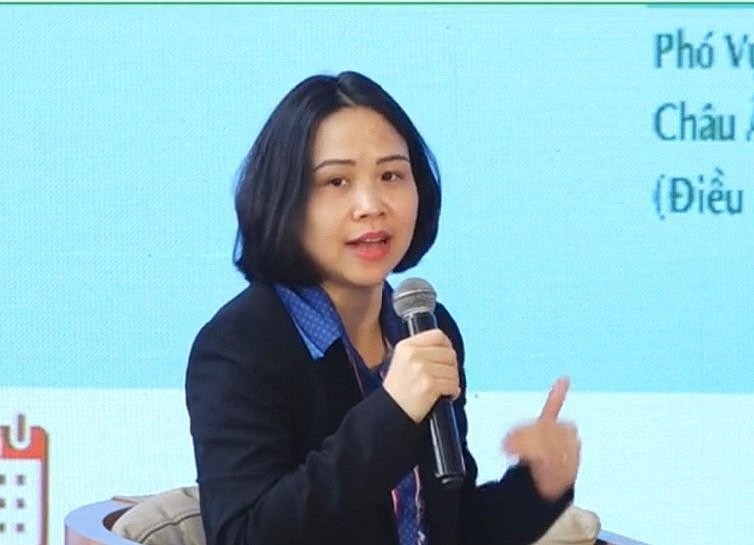 |
| Ms. Nguyen Thao Hien - Deputy Director of the European - American Market Department |
This trend is expected to have a great impact on Vietnam's exports in the near future, increasing technical and administrative barriers for both agricultural and industrial products.
For example, in the EU market, textiles and garments are one of the key product groups that are most significantly affected when they will have to comply with stricter regulations and standards with the recent EU announcement of a textile strategy. circulating sewing.
Or, for Vietnam's wood products, to grow exports, it is also necessary to meet conditions such as VPA/Flegt (Voluntary Partnership Agreement/Forest and Forestry Governance) license, CITES permit, followed by ESG (Environmental - Social - Governance) standards, CO2 emissions...
At this session, we will discuss in depth why it is important to aim for sustainable exports? Challenges need to be solved, specifically in terms of policies and internal enterprises to aim for green and sustainable export in line with the current market development trend. We will also hear very practical sharing from businesses and related organizations.
Speakers with extensive knowledge and experience in sustainable export production to this session include:
- Mr. Jean Jacques Bouflet - Vice President of EuroCham
- Mr. Nguyen Chanh Phuong - Vice President of Fine Arts and Woodworking Association of Ho Chi Minh City. Ho Chi Minh (HAWA)
- Mr. Ly Trung Kien, Head of National Logistics Department, Nestle Vietnam Company.
MC asked Mr. Nguyen Chanh Phuong: How has the signing of FTAs, especially new generation FTAs, brought benefits to the Vietnamese wood industry, sir? Besides the favorable factors, what are the current difficulties and challenges enterprises are facing?
Mr. Nguyen Chanh Phuong:
In the previous discussion session, businesses shared opportunities and challenges when participating in FTAs. Before the FTA, the wood industry had tax advantages when exporting to the EU. However, if FTAs are not signed, it is likely that the tax rates will be high again. With the wood industry, when participating in FTAs, businesses have many advantages compared to other countries. The proof is that the export turnover of wood to all markets keeps a stable level.
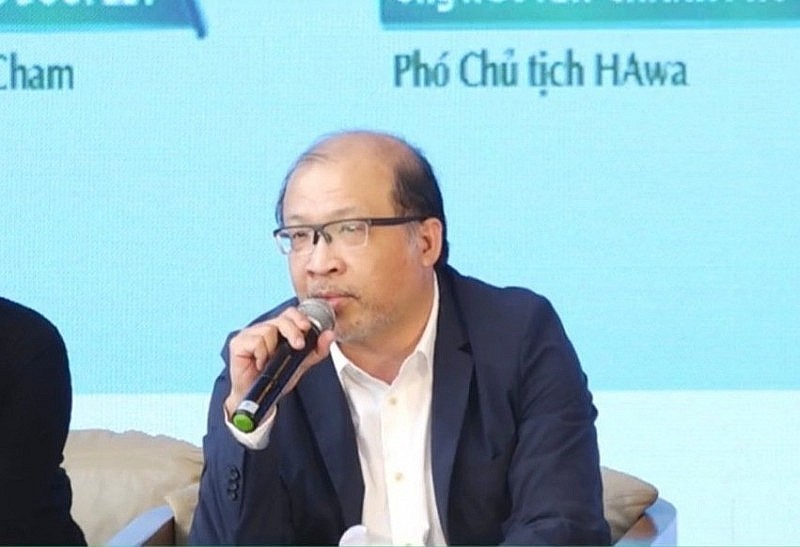 |
| Mr. Nguyen Chanh Phuong |
With environmental, labor or origin requirements, although it is a technical barrier, this is an opportunity to improve the quality of the product. When businesses overcome these requirements, it will create a new step. Therefore, enterprises must consider these environmental and labor requirements as achievements and must be overcome.
Evidence shows that businesses have overcome and achieved many results. Recently, the wood industry has slowed down, this is an opportunity for businesses to look back and rebuild their plans for development. Evidence shows that businesses have overcome and achieved many results. However, since May, the wood industry has slowed down, but this is an opportunity for businesses to look back and rebuild their plans for development.
MC asked Mr. Ly Trung Kien: Could you please tell me how participating in FTAs such as CPTPP, EVFTA is creating opportunities and challenges for coffee production and export in particular and the food industry in general?
Mr. Ly Trung Kien:
There are many advantages as well as challenges that the coffee industry as well as the beverage industry is facing when joining the FTA. Talking about advantages, joining the FTA has created favorable conditions for the coffee industry, especially for partners like Europe. We Vietnamese enterprises also receive more capital for investment and production.
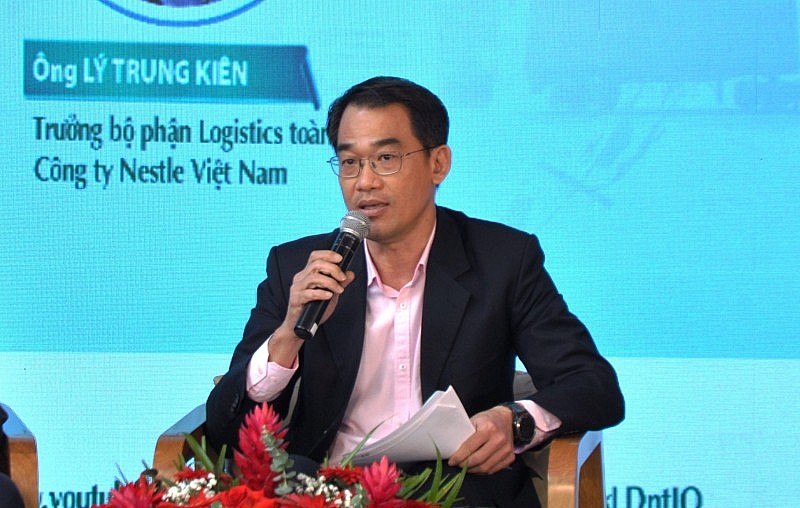 |
| Mr. Ly Trung Kien |
However, coffee enterprises also face many challenges. Firstly, the trend of consumers, especially consumers from Europe and the US, is becoming more and more strict. They care a lot about the source of raw materials, so they set many technical standards that countries must comply with to ensure the sustainability of raw materials.
The second is competition within the bloc. Countries such as Malaysia, Indonesia, Philippines... also have the ability to export coffee. So how can Vietnam compete with these countries? To improve their competitiveness, enterprises need to invest in deep production, not only in production but also in modern technology.
Third, Vietnamese coffee businesses need to pay more attention and invest in the issue of geographical indications. Geographical indications must be clear and transparent to the requirements of these export markets.
MC: Sir Jean Jacques Bouflet, how has the trend of import and consumption in the EU changed? Notably, how do the EU's new policies and regulations related to green production and sustainable development affect exports to the market?
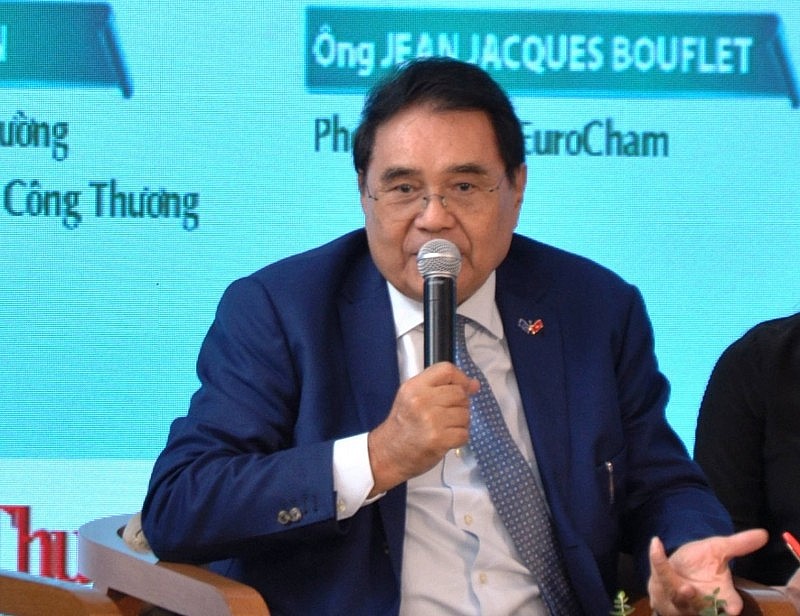 |
| Mr. Jean Jacques Bouflet |
Mr. Jean Jacques Bouflet: Through the pandemic, in general, import policies from the EU have remained unchanged. However, Vietnam has to face obstacles when it has to meet the EU's increasingly strict trend of green and clean consumption, wanting to use green and clean products. For example, with wood products requiring FSC certification, or in the current wood export industry not using wood materials from Russia will affect export activities.
With the coffee industry, it is necessary to ensure a certificate of sustainable development to be able to meet the needs of EU importers.
However, Vietnam is trusted by EU businesses and Vietnam is not closed after the pandemic, so it can ensure stable production and business. This is something that importers trust and appreciate.
In the coming time, Vietnamese enterprises must ensure the emission index, see the sustainable development of enterprises. And an important point that EU consumers need to see is the willingness of Vietnamese manufacturers to change in sustainable development, drastically reducing emissions.
MC: Mr. Nguyen Chanh Phuong, with a series of licensing and certification requirements such as: VPA/FLEGT, CITES and aiming to be ESG... from import markets, according to you, businesses, as well as the export wood industry What solutions do Vietnamese exporters need to adapt and meet new conditions, thereby creating a breakthrough for Vietnam's wooden furniture exports in the near future?
Timber is an industry with a long preparation for environmental regulations. Since 2013 when the EU issued the EU's Regulation on Forest Law Enforcement (VPA/FLEGT), Vietnam has had 6 years to negotiate its implementation.
When talking about FTAs, EU traders and FDI enterprises are faster than Vietnamese enterprises. These traders took advantage of the opportunity to buy goods, while FDI enterprises organized production, development and export to the EU.
However, now in the context of the urgency of climate change and the requirements for green growth, we do not have a long time to negotiate the implementation of the requirements anymore.
Currently, the timber industry has about 14 million hectares of forests, including 4 million hectares of production forests. With good planning, we can ensure 60% of raw materials, the shortfall may lack compensation from the US and Chile.
Therefore, businesses not only ensure environmental criteria in the country but also globally. Therefore, the import of wood must ensure the origin.
The application of criteria on forest law in markets will be very tight, so if businesses cannot ensure it, they will lose business opportunities.
Vietnam has FTAs, so it has more opportunities than other countries, such as China, when China was taxed by the US, Vietnamese businesses quickly made up for this shortfall.
To support businesses, the wood association has made great efforts to get information from the Ministry of Agriculture or pursue opportunities from the Ministry of Industry and Trade. This has helped a lot for businesses.
MC asked Mr. Ly Trung Kien: Can you share specifically about Nestle's adaptation plan in the journey towards sustainable production and export? Solutions to raise the value of Vietnamese coffee in the global supply chain?
Mr. Ly Trung Kien: Since 2011, Nestle Vietnam has been working to increase crop productivity. The company has offered many solutions to support farmers, how to improve crops and methods of selecting varieties for higher yields. Nestle Vietnam's agricultural team has guided farmers to implement, improve coffee crop productivity, and thereby help increase income for farmers.
Here, regenerative agriculture is also one of the topics that Nestle Vietnam encourages and implements. Regenerative agriculture is a guide to rational use of resources, protecting land and water sources to continue to be regenerated and used. Helps to increase soil fertility and increase crop yield.
Better land use will also help combat climate change and increase farmers' incomes. This story of regenerative agriculture will also be widely communicated to consumers, thereby helping to increase the export value of coffee.
MC asked Mr. Jean Jacques Bouflet: Given the changes in consumption trends as well as import policies in the EU in recent years, do you have any notes or recommendations for Vietnamese businesses to increase exports. into the EU in the near future?
Mr. Jean Jacques Bouflet: The main challenge of Vietnamese enterprises is to ensure sustainable export development, meet the requirements of green production, green products, sustainable and reliable development.
Vietnamese exporters need to build their own brands, limit raw exports, and improve processing capacity. In addition, in order to effectively take advantage of the EVFTA, Vietnamese exporters need to maximize their resources to boost exports in the coming time, and quickly increase their market share in the agricultural import market of Vietnam. EU, before the EU deploys to sign FTAs with potential competitors of Vietnam.
To get specific information about these green standards and green production, Vietnamese businesses can join the upcoming green economy forum in Ho Chi Minh City. Ho Chi Minh.
In order to strengthen cooperation and support businesses, Eurocham has signed a cooperation agreement with VCCI, in the coming time, it will work closely with Vietnam's export manufacturing industry associations.
Ms. Nguyen Thao Hien - Deputy Director of the European - American Market Department:
With the sharing and analysis of the speakers, we clearly see the benefits of FTAs as well as the need to change and adapt to the trend of sustainable development, meet the consumer trend. green use, as well as strict regulations from import markets. In other words: Sustainable export production will be the key to success for businesses in the future.
Vietnamese enterprises need to actively grasp and adjust production and business plans in a timely manner to promptly adapt to new market requirements and regulations, and participate effectively and sustainably in the supply chain. . Efforts to greenen production, as well as implement social responsibilities, and protect the environment need to be focused and further promoted. Accordingly, innovating technology, investing in modern machinery lines according to international standards, aiming at green, clean and environmentally friendly production criteria and ensuring conditions for employees as the solution group. necessary law.
Regarding sustainable export development, the Ministry of Industry and Trade has developed and submitted to the Prime Minister for approval and issued Decision No. 493/QD-TTg dated April 19, 2022 approving the import-export strategy. to 2030.
According to this strategy, the export orientation of goods requires sustainable export development, promotion of comparative advantages and transformation of a rational growth model in depth, efficient use of resources, environmental protection. ecological environment and solve social problems well.
In the coming time, performing the tasks assigned by the Prime Minister, the Ministry of Industry and Trade will assume the prime responsibility for, and coordinate with ministries, sectors, localities and industry associations in formulating action plans to organize the implementation of this program. implement the Strategy to ensure practicality and efficiency, so that import and export activities continue to be the driving force of the country's rapid and sustainable economic growth. However, towards this goal, there is still a long way to go with many problems and need the cooperation of the business community and industry. Hopefully, the recent sharing of the speakers will help businesses, especially small and medium-sized enterprises, find solutions to promote effective and sustainable exports in the near future.
MC: The wood industry is said to have more opportunities than challenges from the CPTPP and benefits from tariffs, so according to Mr. Tran Quoc Manh, how do you evaluate this statement?
Mr. Tran Quoc Manh - Chairman of the Board of Directors of Saigon Trading Production Development Joint Stock Company (SADACO):
I think that in the context of the economy is facing many challenges, FTAs still bring many opportunities for businesses. Sadaco is a long-standing timber export company in the South, the common policies and FTAs have a very strong impact. In 2014, Vietnam's wood exports to the US market were insignificant. But after 15 years, exports to this market now account for about 60% of the total export volume to these markets.
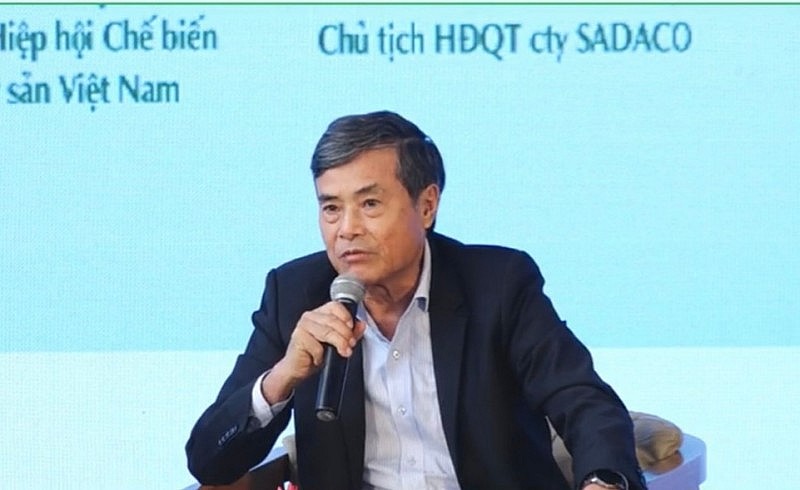 |
| Mr. Tran Quoc Manh |
We appreciate that the Ministry of Industry and Trade has negotiated and signed to put the CPTPP into practice. After 3 years, businesses, especially small and medium enterprises, thanks to the CPTPP, have matured and integrated into the global economy. This agreement has helped businesses go deep into the global supply chain and each business is in tune with the breathing of world businesses. As a result, up to now, Vietnam's wood products have gained brands in major markets and emerging markets.
MC: Being both an exporter of agricultural products and vice chairman of the Vietnam Fruit and Vegetable Association, Mr. Nguyen Dinh Tung would like to say how do you assess the opportunities and challenges for the fruit and vegetable industry?
Mr. Nguyen Dinh Tung: For fruit and vegetable export, Vietnam is currently recording some advantages from new generation FTAs. Typical businesses such as the EU have oriented towards the Vietnamese market more. In my opinion, when exporting fruits and vegetables to FTA markets, the tariff problem is only one part. Currently, the problem that we are facing is the technical barriers. To be able to participate more deeply in this playing field, Vietnamese businesses must strictly adhere to the rules of each market in that country.
For example, the EU market thinks it's "easy but difficult, hard to be easy" because goods exported to the EU do not need to be negotiated. The EU allows all kinds of fruit to enter but they control over 30 types of residues and they control this very strictly.
Currently, Vietnam has an advantage to export vegetables and fruits that is that Vietnamese farmers can produce products all year round. In addition, many trade promotion programs are also implemented by the Ministry of Industry and Trade to support businesses. However, one weakness that Vietnamese businesses need to overcome is that the marketing of their products is still not good, and foreign businesses do not know much about them. Particularly in this field, your country like Thailand does much better than ours. In the coming time, businesses need to promote more product promotion.
MC: Another question I would like to ask Ms. Tuong Lan, after the pandemic, the world situation has many stressful factors such as inflation occurring in many countries, military and commercial conflicts are still complicated. What do you think about the difficulties that seafood businesses will have to face?
 |
| Ms. To Thi Tuong Lan |
Ms. To Thi Tuong Lan: The seafood industry is a strong spirit, in all circumstances businesses find a way to deal with the impact of each market. However, businesses must build strong internal resources to solve problems.
Like Nestle just presented. Vietnam is a big exporter, but there is no strategy to export deeply processed or organic products, which we currently export more than 80% raw to other countries for processing. Therefore, enterprises should have a strategy to shift to exporting deeply processed products.
To do this, the authorities must support and develop more supporting industries. Specifically, besides capital, enterprises must consolidate resources. Must follow world standards for deeper market penetration. This is also the only way to affirm the capacity of the business.
MC: Through the export experience of the food industry, according to Ms. Ly Kim Chi, what standards will the world's food industry follow and what must businesses do to meet?
Ms. Ly Kim Chi: First, businesses have to keep pace with the market in order to offer the products the market needs. Typically with the Japanese market, this is a market with an elderly population, older people are more than young people, so when exporting to this market, businesses must make green products, suitable for age.
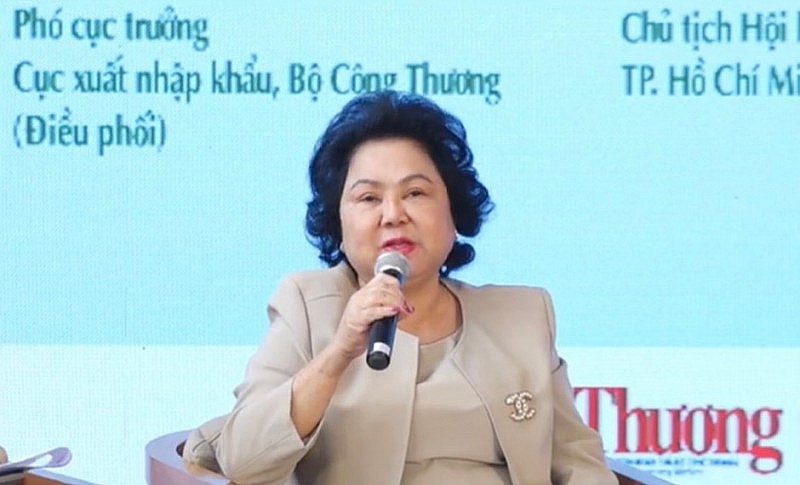 |
| Mrs. Lee Kim Chi |
Failure to catch up with the market causes businesses to miss out on many orders. Most recently, a Vietnamese instant noodle factory received a huge order from the US. When sending samples, the price is accepted by the customer. However, one point is that customers do not accept the use of aluminum lids on noodles. The customer responded and instructed to amend, but the business refused and the business missed the order. The story about noodle cup lids, or plastic trays containing seafood products shows that catching up with the market is not simple when businesses do not change. Therefore, businesses are forced to do in-depth market research, research market standards, and change models according to demand.
MC: From the perspective of your business, according to Mr. Tran Quoc Manh with the wood industry, how will the import trends of other countries change in the near future? And how will Vietnamese businesses respond to those changes?
Mr. Tran Quoc Manh: Currently, although the CPTPP has brought advantages, the wood industry is facing two difficulties. Firstly, the purchasing power and orders of the wood industry have decreased by 50%. And the second problem is the current internal strength of enterprises. For export businesses, cash flow is showing signs of being congested due to difficulty in accessing capital.
Therefore, through the CPTPP, we expect to see emerging markets, such as Canada, Chile, and Peru.
With Sadaco, we import materials from Chile and wood products here are very cheap. And in the context of emerging markets for new products such as wood pellets, our company can invest in a joint venture to produce wood pellets for export to the EU, the US...
Like our story, I think it's time for Vietnamese businesses to think about investing abroad.
MC: A general question for the speakers, from the perspective of associations/enterprises, what recommendations do you have for the fisheries/food/wood/vegetables industry to make good use of the CPTPP in order to make a better breakthrough in the current period? next time?
Ms. To Thi Tuong Lan: There are currently 3 major difficulties in the fisheries sector: credit, trade promotion and land fund for farming.
Specifically, with the seafood industry, only about 60% of businesses are disbursed credit. In the fourth quarter, many small and medium enterprises were not disbursed and had no orders. This puts businesses at risk of bankruptcy. Therefore, it is necessary to have solutions to support businesses in terms of capital.
The second is about Trade Promotion, in order to have market information, businesses and industries need to build a deep relationship with trade counselors.
Third, there should be a land fund for aquaculture development. The seafood industry, when entering the FTA, it is very important to meet the rules of origin, currently 60% of seafood is aquaculture but the land fund for development is very limited. With fishing, we are entangled in IUU, so we also hope the Government will support businesses to remove the yellow card in 2023.
Ms. Ly Kim Chi: In the first 8 months of the year, the export products of the industry grew by 25-40%, which is very favorable. However, enterprises in the industry are currently facing two major difficulties.
Firstly, it is very limited for enterprises to open markets or promote trade by themselves, so the Association recommends units to carry out more trade promotion programs to foreign markets. If this work is done well, enterprises will export better.
Secondly, with the food industry at this time, we have to stockpile a lot of domestically produced materials. For export orders, raw materials must also be prepared, but now the credit room is cut or tightened, making it very difficult for businesses.
I think that in order to support businesses, we need to support businesses to participate in trade promotion and secondly, we need to open the credit room for businesses.
Mr. Tran Quoc Manh - Chairman of the Board of Directors of Sadaco: I would like to add Ms. Ly Kim Chi's opinion. With business, specific information about each market is very little. For example, Canadian businesses really want to penetrate this market and they want to know how this market has market demand... so they need more specific information.
Previously, the wood industry had many fairs and exhibitions and the Ministry of Industry and Trade organized many successful trade trips. However, many programs have been suspended recently. Therefore, businesses recommend reopening these fairs, regularly organizing foreign trade meetings.
Mr. Nguyen Dinh Tung: Currently, we have been participating in many fruit and vegetable trade promotion activities with our partners. Through this, we realize that the Nordic and Russian markets pay special attention to Vietnamese fruit and vegetable products.
Regarding recommendations, in fact, not only Vietnam's fruit and vegetable industry but also other export industries, the most difficult thing for businesses today is cash flow. Lack of cash flow, export businesses will be "stuck". In the coming time, we hope that when the cash flow is circulated, the export business will develop more smoothly.
MC: So after 3 years of implementing the CPTPP, although there are still many challenges, we have achieved very encouraging results, especially in the context of being affected by the epidemic as well as the trade war in the world. gender. Especially the impressive increase in export turnover to markets without FTAs, such as Canada, Mexico, and Peru. This also shows that, despite the difficulties, Vietnamese enterprises have caught up with the commitments and regulations brought by the CPTPP, demonstrating the ability to adapt flexibly.
In order to support businesses to quickly adapt to commitments from this FTA, the Ministry of Industry and Trade has been strengthening activities to disseminate and propagate commitments as well as rules of origin; boost export promotion on digital platforms, support trade connection; propagandize and support businesses to avoid the risk of being applied trade remedies when exporting goods to the CPTPP market.
Hopefully, the recent sharing of the speakers will help businesses, especially small and medium-sized enterprises, find solutions to promote exports to CPTPP countries in the near future.
Discussion session 1: Vietnam after 3 years of implementing CPTPP - Business perspective
Coordinator: Ms. Do Thi Thu Huong - Deputy Director of Import-Export Department - Ministry of Industry and Trade
After 3 years of implementing the CPTPP, it can be said that Vietnamese enterprises have taken advantage and relatively effectively exploited the benefits brought from the agreement, thereby increasing the export of goods to CPTPP markets, especially especially the new market in the Americas region.
Specifically, in the first eight months of 2022, export turnover between Vietnam and CPTPP member countries reached US$31.4 billion, up 22.2% over the same period in 2021. In the opposite direction, turnover Vietnam's imports from this region reached 27.9 billion USD, up 16.1% over the same period in 2021. The trade surplus after 8 months was 3.5 billion USD.
However, despite impressive results, the commitments and regulations in the CPTPP are relatively new and complicated, so many Vietnamese businesses are still confused and have not made the most of the incentives. In particular, in 2022, after nearly 2 years of fighting the pandemic, when economies and trade activities between countries around the world normalize again, many countries begin to set higher standards with imported goods to protect domestic production as well as the health of consumers.
Therefore, at this discussion session, we will focus on discussing 3 main contents: First, the results achieved by each industry or field after 3 years of implementing the CPTPP; second, information related to import policies of CPTPP countries after the pandemic; and finally, the trend of importing goods with a focus on sustainable products and environmental protection as well as recommendations to make better use of the CPTPP in the near future. (Priority to interact with the audience).
The first discussion session was attended by:
Ms. To Thi Tuong Lan - Deputy Secretary General of Vietnam Association of Seafood Exporters and Producers
Ms. Ly Kim Chi - Chairman of the Food and Food Association of Ho Chi Minh City. Ho Chi Minh City (FFA)
Mr. Tran Quoc Manh - Chairman of the Board of Directors of Saigon Trading Production Development Joint Stock Company (SADACO)
Mr. Nguyen Dinh Tung - Vice Chairman of Vietnam Fruit and Vegetable Association, Chairman of the Board of Directors of Vina T&T Import-Export Trading Service Co., Ltd.
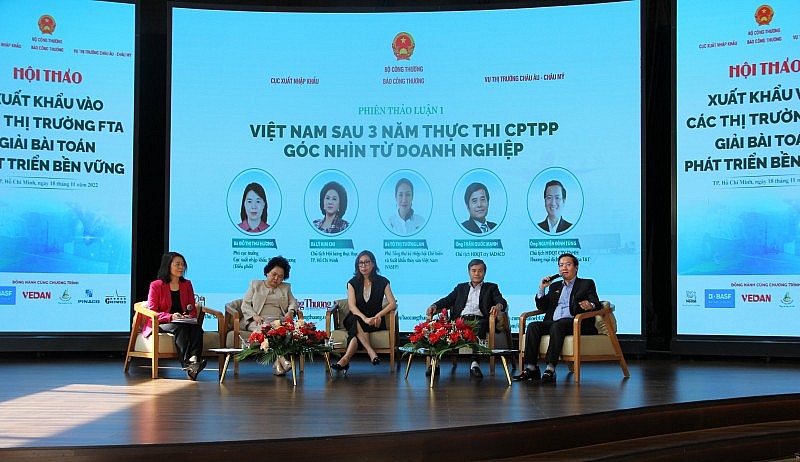 |
| Discussion session 1 |
MC: Madam Tuong Lan, seafood is an assessed industry that is taking advantage of the opportunities brought by the CPTPP, could you tell us about the results that seafood has achieved after 3 years of the CPTPP taking effect? Among the CPTPP countries, which markets are growing the most and which products are they focusing on?
Ms. To Thi Tuong Lan - Deputy Secretary General of Vietnam Association of Seafood Exporters and Producers:
Currently, according to the structure of the seafood export market, Vietnam is the third largest exporter in the world after Norway and China. The largest export market share of Vietnamese seafood is to the United States, then China and finally South Korea. Vietnam's seafood exports to the CPTPP market account for nearly 27%.
Up to the end of October 2022, exports to this market have reached nearly 2.3 billion USD, an increase of 14% compared to 2018, the time before the signing of the CPTPP Agreement and an increase of about 40% compared to the same period. period.
Most seafood exports to CPTPP countries have increased. Some markets like Japan grew by about 33%. Canada up 67%, Australia up 58%...
MC: Another question for Mrs. Ly Kim Chi, how do you assess the impact of the CPTPP on businesses in the food industry? Have businesses in the Association taken advantage of the CPTPP to export food and food products and what is the biggest difficulty businesses are currently facing?
Ms. Ly Kim Chi: Over the past 3 years, the CPTPP has opened up great opportunities for Vietnamese export businesses, including the food industry. Specifically, before the implementation of the CPTPP, Vietnam's processed food products could not access these markets due to tariff barriers. However, since the CPTPP came into effect, Vietnamese goods have been able to access these markets. In the past 3 years, the export growth of food and food enterprises has reached a high level. To do this, businesses have tried very hard to change their production thinking and ensure the quality of goods.
Most recently, Vietnam has successfully exported rice to the EU market at a higher price than Thailand. This is the result of the enterprise's preparation from seed to planting.
Up to now, many businesses in the industry have received large orders, even businesses have to refuse to reduce orders.
However, besides the advantages, the food industry also faces many difficulties in terms of non-tariff barriers such as rules of origin, quality of goods, and anti-dumping. Meanwhile, the food industry enterprises are mainly small and medium enterprises, rarely face this situation.
Typically, in the past, with growing areas, people had almost no traceability, but now, in order for goods to be exported, businesses have to trace the origin of goods.
In that context, businesses must coordinate with associations, industries and ministries to minimize risks.
Need to invest for sustainable development
Mr. Ly Trung Kien, Head of National Logistics Department, Nestle Vietnam Company shared, Nestle is the largest coffee purchasing factory in Vietnam with a purchasing level of approximately 600-700 million USD/year. Currently, the company's products have been exported to many countries around the world, including many fastidious countries such as the US, EU...
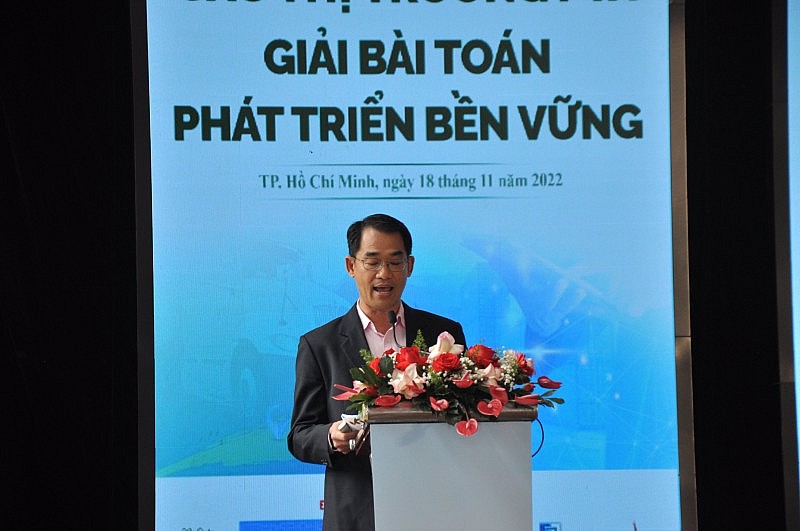 |
| Mr. Ly Trung Kien, Head of National Logistics Department, Nestle Vietnam |
In the past time, the company has implemented many programs to bring sustainable coffee products to the world. Accordingly, the unit has built a sustainable coffee value chain through the development of sustainable coffee raw materials. For example, the NESCAFÉ Plan program. This is a program of “Creating Shared Value” to improve the productivity and quality of Vietnamese coffee through sustainable farming, raising farmers' incomes and contributing to the reduction of greenhouse gas emissions. The program has been implemented in Vietnam from 2011 to present.
To sustainably export to FTA markets, the Nestle representative recommended, businesses need to invest in sustainable development throughout the value chain. Accelerate application and digital transformation. At the same time strengthen cooperation and connection with each other. On the Government side, Mr. Ly Trung Kien said that the Government should strengthen policies to support sustainable development, invest in infrastructure and promote multilateral cooperation.
BASF Vietnam helps to make exports more sustainable to the EU
Erick Contreras, General Director of BASF Vietnam, said that the EVFTA offers an opportunity to deeply reduce tax rates for Vietnamese exporters, but also sets high requirements on the environment and human people in addition to very strict standards for product safety and quality. BASF Vietnam is a companion to help businesses solve the problem of sustainability. As a leading global chemical company headquartered in Germany, BASF provides advanced chemical raw materials and solutions that help businesses meet the aforementioned technical barriers.
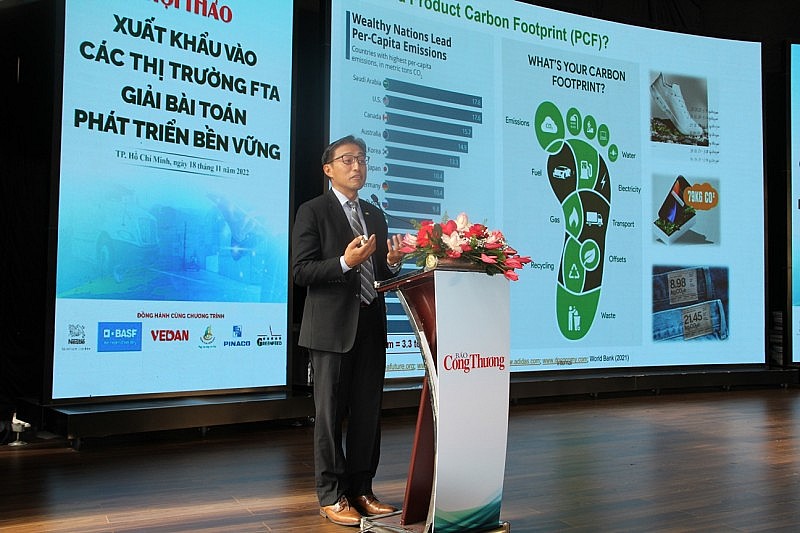 |
| Mr. Erick Contreras, General Director of BASF Vietnam |
The company's solutions can help two key export industries, garment and footwear, achieve quality improvement requirements while minimizing impacts on health and the environment. Specifically, with the footwear industry, BASF brings durable fashion products, improving health and protecting the environment. BASF's Elastopan® PU sole is 25% lighter than similar materials, has good shock absorption and 50% higher bounce, helping footwear improve safety, health and aesthetics as well as performance and comfort. The product does not contain solvents and heavy metals. CO2 emissions are minimized in the production process. At the same time, Elastopan® is recyclable.
As a result, this material can also help fashion brands minimize CO2 emissions in the production process. For the textile industry, BASF's high-performance Lutensol®, Sokalan®, Agnique® material lines can shorten the production process in textile dyeing plants, meeting a variety of operating conditions (in terms of temperature and temperature). temperature, pH, electrolyte composition, etc.), thereby saving clean water as well as energy consumption. Many of BASF's product lines, such as Trilon®M, are 100% plant-based or renewable, naturally biodegradable, and can be treated after use to treat wastewater for reuse.
Similarly, BASF's Hydroblue® 90 material makes the denim textile dyeing process safer and healthier for workers thanks to its low odor feature with 200 times lower sulfuric content than conventional. The product is also dust-free, uses less heavy metals, and is efficient in water and energy use, while ensuring stable, fast dyeing quality, thus meeting the requirements of leading brands. The brand is famous worldwide not only for quality but also for ecological factors. Equally important, the EU is increasingly demanding cleaner production processes with less CO2 emissions.
By 2026, EU importers will have to disclose the previous year's respective imports and emissions, in parallel with CBAM (Carbon Border Adjustment Mechanism) certificates. BASF provides reliable data showing emissions related to 45,000 of its global raw material products from input to release. The calculation method is based on the amount of greenhouse gas emissions generated from the extraction of raw materials to the production of precursors and final products, up to the time the product leaves the factory. As a result, Vietnamese manufacturers will have full information about BASF materials to help them reduce emissions for their products and business in general. This transparency will help them better meet EU standards on CO2 and work towards a more sustainable business model.
With the above diverse solutions for many production areas, especially in agricultural production, BASF Vietnam will help businesses export more sustainably to the EU market in the future.
High efficiency from EVFTA
After the Covid-19 pandemic, export markets all tended to change in terms of import policies, non-tariff barriers and consumption trends. Information about changes in import trends from Europe, regulations to be noted on non-tariff, focus on sustainability, Mr. Jean Jacques Bouflet - Vice President of EuroCham - said: Up to now, The EU is the world's second largest import market with an annual import turnover of about 5,015 billion USD (in 2020), Vietnam's exports to the EU to the EU reach about 40 billion USD per year, accounting for a very modest market share compared to that of the EU. EU import potential.
 |
| Mr. Jean Jacques Bouflet - Vice President of EuroCham |
Last August, 2022 also marked an important milestone of 2 years since the Vietnam - European Union Free Trade Agreement (EVFTA) took effect. The EVFTA is one of the few agreements with very high standards, with a tariff liberalization rate of basically over 90% within 7 years of implementation. In the initial stage of implementation, although the international context was not completely favorable, the Covid-19 pandemic complicated developments, disrupted the supply chain, affecting the global economy and Vietnamese businesses. However, the growth of Vietnam's exports to the EU is about 14% annually.
According to the latest data for the 10 months of 2022, the total export and import turnover of Vietnam's goods reached USD 616.24 billion, up 14.1% over the same period last year. In which, exports to the EU market reached 39.4 billion USD, up 22.3%. The EVFTA Agreement has created favorable conditions to increase the export of Vietnamese goods with strong market opening commitments, commitments to eliminate import taxes up to nearly 100% of the tariff in EVFTA, UKFTA, and opportunities. Vietnam's export growth still has a lot of room. Especially, because of the difference in soil and climate conditions, the agricultural economy of the two sides is very complementary, the potential for export to the EU market in the field of agriculture, forestry and fishery is very large. However, the barrier is not small.
Up to now, entering the 3rd year of implementing EVFTA, the preferential margin, the level of incentives that businesses enjoy is large enough to create a stronger export motivation. Therefore, in the coming time, Vietnam needs to focus on promoting better enforcement, especially in the context of still complicated international affairs, armed conflicts, and rising prices of some raw materials, reducing the total demand of the country. EU market.
According to Jean Jacques Bouflet, in addition to the EVFTA with Vietnam, the EU has 41 other FTAs that have taken effect with 78 countries and territories around the world, but mainly concentrated in Europe and the Americas. In Asia, the EU has only established FTA relationships with 12 countries, of which only Vietnam and Singapore are in Southeast Asia.
“Thus, in the short term, Vietnamese goods exported to the EU will have a significant competitive advantage over many other competitors in Southeast Asia thanks to the EVFTA. This attractive export prospect will also attract FDI from countries that have not signed Agreements with the EU, " - Mr. Jean Jacques Bouflet emphasized.
Jean Jacques Bouflet said that, in order to make more effective use of the EVFTA, the most important thing is to provide sufficient information for the business community to make the best use of existing regulations. In addition, strong support is needed so that businesses can grow up, learn better information when participating in the EU market, and overcome challenges, technical barriers, and new consumer trends. originated in the EU market.
“Currently, the EU market is tending to move very strongly to consume green, clean goods and meet labor and environmental standards… that is, they do not simply ask for prices, quality, but also care about the production process of that good. Therefore, in order to speed up the effective implementation of the EVFTA, businesses need to anticipate this trend. If they succeed in following this trend, the value obtained in the process of exporting to the EU will be much larger. Besides, entering the EU market with the condition that exported goods must overcome non-tariff barriers. This is inherently an important challenge for Vietnamese businesses in general and developing countries in particular,” said Mr. Jean Jacques Bouflet.
Note for businesses
In order for Vietnamese goods to be exported to the EU to enjoy this preferential tariff advantage, Mr. Jean Jacques Bouflet noted: Basically, 2 conditions are needed, firstly, the goods must meet the required market standards, but specifically are the sanitary and phytosanitary measures (SPS) and technical barriers (TBT) related to the product, secondly the product must meet the rules of origin. The commodity groups with the highest frequency of applying SPS and TBT when imported into the EU are vegetables, processed foods, textiles, leather goods, chemicals, footwear, plastic products, etc. Vietnam's main export products.
Therefore, it is necessary to study and grasp the nature of these non-tariff barriers in the context that Vietnam has signed the EVFTA Agreement and businesses need to meet the standard conditions to meet the measures. The new SPS and TBT can take advantage of tariff reductions from the Agreement to increase exports to the EU.
Firstly, increase awareness of EU regulatory changes: EU regulations are regularly adjusted and changed. Therefore, manufacturers and companies exporting products to the EU need to pay attention to check and update relevant EU legal documents, and regularly review notices of changes in EU regulations. For aquatic products, it is necessary to control, manage and use in accordance with regulations on the quality of animal feed in aquaculture and strictly control hazards that cause food insecurity during preliminary processing. , Processing. For fruit products and processed foods, it is necessary to control, manage and use in accordance with regulations on plant protection chemicals (MLR), strictly control hazards that cause food insecurity during processing. processing, packaging…
Businesses can review notifications of EU regulatory changes through the ePing portal. ePing, a joint initiative of the UN, WTO and ITC, is an online tool that allows stakeholders to access and discuss WTO SPS/TBT announcements that affect the products and markets they are interested in. attention in a timely manner. Therefore, businesses need to register for ePing, to receive daily or weekly email alerts of SPS/TBT notifications related to products entering the EU market.
In addition, businesses related to the food industry need to update information through the EU's RASFF Portal - the Rapid Alert System for Food and Feed - which allows EU member states to react quickly when detect in the food chain a risk to public health and promptly notify.
Second, the recommendations related to the production process: The necessary condition for Vietnamese goods to enter the EU market is to meet the requirements of TBT and SPS. This requires enterprises to invest in both depth and breadth, ensure strict control of product quality and the entire production process, not only at the last stage can they overcome the challenges in terms of products and services. measures SPS, TBT.
Currently, there is a gap between Vietnamese standards and international standards. For example, Vietnam is widely applying VietGap standards, however, import markets and global consumers prefer Global Gap, BAP and other international standards. Vietnamese enterprises need to focus on EU standards to design production, processing and farming processes. Although these standards are higher than Vietnam and standards in other markets, it will be difficult and costly to invest from the beginning, but with a long-term vision, it will help to penetrate the EU market sustainably and Once the EU market is accessible, the diversification into other markets will be more favorable. This requires business leadership thinking and the support of state management agencies.
Tuesday,Strengthening measures to combat origin fraud: EVFTA opens up attractive export prospects, on the positive side will attract more FDI investment into Vietnam, especially from producing countries that have not yet entered into agreements. favorable trade agreements with the EU like Vietnam. The forging of Vietnamese origin, illegal transshipment for export will increase the risk that the EU will apply emergency TBT and SPS tariff barriers and trade remedies to Vietnamese goods. The prevention and handling of origin fraud requires the participation and cooperation of many ministries and sectors, especially the business community in raising awareness about origin fraud prevention. aiding in fraudulent activities and requires full coordination of relevant agencies and the role of providing timely and real-time information of the General Department of Customs.
The EU implements a set of policies and actions called the European Green Deal, with the goal that by 2050 the European economy will be more sustainable and carbon neutral. The action plan also sets out a target to reduce pesticide use by 50% and increase the share of farmland used for organic agriculture to 25% by 2030. This means more pesticides. Plants will be banned in the EU, and residue levels will gradually decrease in the coming years. Vietnamese businesses need to pay attention to this organic consumption trend in their long-term development strategy.
Bright picture of goods exports to the EU
Sharing at the seminar, Ms. Nguyen Thao Hien - Deputy Director of the Europe - America Market Department shared the picture of exports to the EU market after 2 years of implementing the EV FTA.
Nguyen Thao Hien said that after more than 2 years of implementing the EVFTA, Vietnam's exports to the EU have recorded positive results. Accordingly, in 2021 and the first months of 2022, two-way trade between Vietnam and the EU will continue to recover and grow very strongly, even compared to the pre-pandemic period. The EVFTA Agreement has actively supported Vietnamese and EU goods to access each other's markets, meeting the needs of supply diversification of both sides.
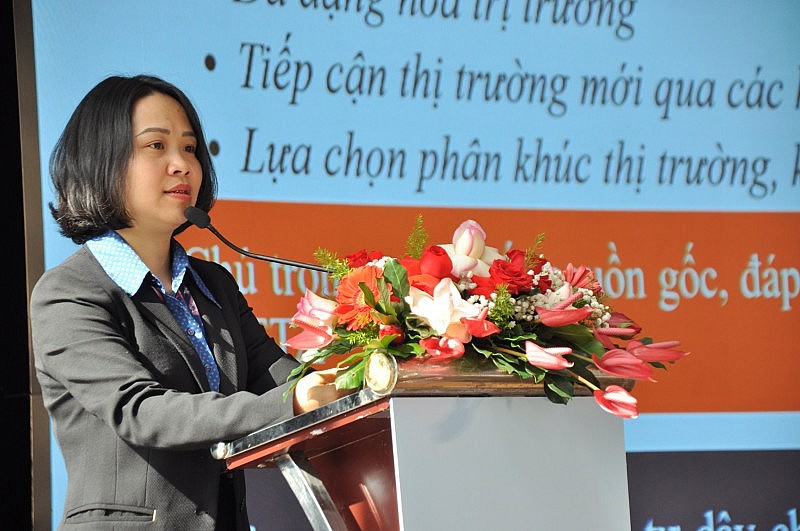 |
| Ms. Nguyen Thao Hien - Deputy Director of the European - American Market Department |
Data from the General Department of Customs shows that in 2021, two-way trade turnover between Vietnam and the EU will reach 57.01 billion USD, up 14.5% over the same period in 2020, of which Vietnam's exports will reach 40. 1 billion USD, up 14.2%; imported USD 16.9 billion, up 15.3% over the same period in 2020.
In the first 10 months of 2022, the import and export turnover of goods between Vietnam and the EU reached 52.5 billion USD, up 14% over the same period last year; in which exports reached 39.7 billion USD, up 23.5%.
The EU is currently Vietnam's top trading partner and the third largest export market with an average export growth rate of 7.5%, accounting for an average share of 13.6% of total exports. of the whole country (2015 - 2021)" - Ms. Nguyen Thao Hien shared.
In the opposite direction, Vietnam surpassed Singapore to become the EU's largest trading partner in ASEAN and ranked 11th among the largest suppliers of goods to the EU (in 2021- according to Eurostat).
Along with that, Vietnam's exports to most markets in the EU recorded good growth and witnessed a positive shift; Not only focusing on large markets, EU gateways such as Germany, the Netherlands, France ... but exports are gradually being promoted to smaller markets, niche markets such as in Northern Europe, Eastern Europe or Southern Europe.
Notably, the structure of exports to the EU also tends to expand and diversify when not only key commodities have achieved impressive growth rates such as machinery and equipment (43%), shoes footwear (54%), textiles (44%), but the export turnover of many agricultural, forestry and fishery products is also increasing at a very high rate, notably: coffee (43.4%), seafood (31 .6%), vegetables (23.5%), rice (12.2%)…
In particular, the EU is the second largest import market in the world with an import scale of about 2.1 trillion EUR (in 2021), while the market share of goods imported from Vietnam only accounts for nearly 2% (according to Eurostat). ); The structure of import and export of goods between Vietnam and the EU is also largely complementary, not directly competitive. Therefore, the market space is still relatively large for businesses to promote exploitation in the near future. There are still many challenges…
The opportunity is present, however, to make the most of the incentives from the EVFTA, there are still many challenges, especially in the context that the international situation is forecast to remain complicated and unpredictable, especially the local instability. regional and global politics, potential risks of economic recession, supply chain disruption.
Specifically, the commodity trading market has been experiencing complicated movements in terms of supply and prices. Although export activities from Vietnam to the EU market area are not directly affected, they are facing many limitations such as: Prices of food items on the world market are subject to fluctuations; cargo transportation activities are difficult in terms of time and cost; fear of payment risks; raw material prices for production increased; The possibility that the EU's economic growth will slow down due to being heavily affected by regional conflicts and record high inflation will have a significant impact on consumer spending, affecting import demand.
Especially, the EU will increase the application of non-tariff barriers, tighten regulations and technical standards on environment/climate, sustainable development. Meanwhile, many Vietnamese export products are still facing difficulties in accessing the EU market because they have not fully met the EU's high requirements set out from regulations, technical standards, and traceability. , to environmental issues, society, sustainable development .... The EU also regularly reviews and adjusts regulations, making it difficult for Vietnamese businesses in many cases to grasp and adapt.
What should businesses pay attention to?
Facing the advantages and challenges intertwined in the coming time, Vietnamese enterprises need to make efforts to innovate themselves, prepare a methodical plan to make the most of market opportunities and great advantages from the EVFTA. .
Specifically, actively seek market information, consumer tastes, update new requirements and regulations to promptly adapt and adjust production and export plans accordingly. Have a long-term vision and business strategy for each specific product